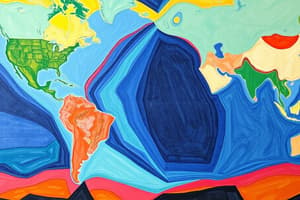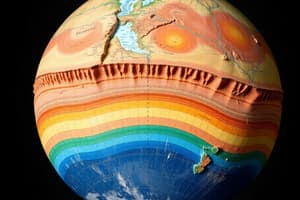Podcast
Questions and Answers
According to the theory of plate tectonics, what sections is the Earth's crust broken into?
According to the theory of plate tectonics, what sections is the Earth's crust broken into?
Plates
These sections are called ________.
These sections are called ________.
Plates
The two parts that combine to form lithosphere are _______ and ____ __ ___ _________ ________.
The two parts that combine to form lithosphere are _______ and ____ __ ___ _________ ________.
Crust; part of the Upper Mantle
What is the name of the plastic-like layer below the lithosphere?
What is the name of the plastic-like layer below the lithosphere?
What is the place where two plates meet called?
What is the place where two plates meet called?
Name the three types of boundaries.
Name the three types of boundaries.
Divergent boundaries involve ______ and have ________ volcanic activity.
Divergent boundaries involve ______ and have ________ volcanic activity.
Convergent boundaries involve ______ and have ________ volcanic activity.
Convergent boundaries involve ______ and have ________ volcanic activity.
Transform boundaries involve _______ and have ________ volcanic activity.
Transform boundaries involve _______ and have ________ volcanic activity.
What occurs at divergent boundaries?
What occurs at divergent boundaries?
What happens at convergent boundaries?
What happens at convergent boundaries?
What occurs at transform boundaries?
What occurs at transform boundaries?
What is convection?
What is convection?
What do differences in density cause hot rock to do?
What do differences in density cause hot rock to do?
Why do Earth's plates move?
Why do Earth's plates move?
What happens when faults form?
What happens when faults form?
Faults move ______ ________ out of place.
Faults move ______ ________ out of place.
How are fault-block mountains formed?
How are fault-block mountains formed?
What is formed when Earth's crust separates?
What is formed when Earth's crust separates?
What causes mountain ranges to form when plates collide?
What causes mountain ranges to form when plates collide?
Who studies volcanoes?
Who studies volcanoes?
Strike-slip faults are caused by __________ boundaries.
Strike-slip faults are caused by __________ boundaries.
What can scientists use to measure the movement of plates?
What can scientists use to measure the movement of plates?
Flashcards are hidden until you start studying
Study Notes
Theory of Plate Tectonics
- Earth's crust and part of the upper mantle are divided into sections known as plates, which are constantly in motion.
- Plates move on a malleable layer of the mantle called the asthenosphere.
- The lithosphere is composed of the crust and the upper part of the mantle.
Plate Boundaries
- Boundaries are locations where two plates meet, influencing geological activity.
- Three primary types of plate boundaries:
- Divergent: Plates move apart, associated with volcanic activity and features like rift valleys and the Great Rift Valley.
- Convergent: One plate subducts beneath another, leading to the formation of volcanoes, deep-sea trenches, and mountain ranges like the Andes Mountains.
- Transform: Plates slide past each other, usually resulting in earthquakes, exemplified by the San Andreas Fault.
Types of Boundaries and Their Impacts
- Divergent Boundaries
- Plates move apart, causing seafloor spreading.
- Convergent Boundaries
- A denser plate sinks beneath a lighter plate, resulting in magma creation, volcanoes, and geological structures over time.
- Transform Boundaries
- Plates slide laterally, causing shear stress which leads to strike-slip faults and seismic activity.
Geological Processes
- Convection currents within Earth's mantle circulate heat, causing rock to rise, cool, and sink.
- Faults form when crustal blocks fracture and move along planes, causing displacement in rock layers.
- Fault-block mountains arise when tectonic forces stretch the Earth's crust, disrupting rock layers and forming elevated structures.
Geological Features
- Rift valleys and mid-ocean ridges form when Earth's crust thins and separates.
- Mountain ranges result from the folding and faulting of rock layers during plate collisions.
Earthquake Mechanics
- Strike-slip faults occur along transform boundaries, where plates move in opposite directions or at different speeds, leading to seismic activity.
Monitoring Plate Movements
- Scientists utilize lasers and satellites for precise measurements of plate movements and geological changes.
Specializations in Geology
- Volcanologists specialize in studying volcanoes and their activity, contributing to understanding volcanic landscapes and eruptions.
Studying That Suits You
Use AI to generate personalized quizzes and flashcards to suit your learning preferences.




